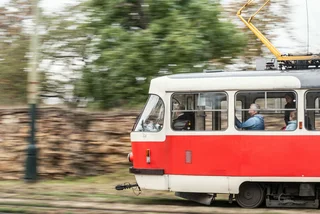Reaching the park on Vítkov Hill from Prague’s Karlín district is likely to become much easier with the planned construction of a new barrier-free footbridge over the railway lines at Pernerova street.
The new footbridge connects to the Holešovice-Karlín footbridge over the Vltava, which is currently under construction, in an extended line along Peckova Street. This will create a convenient pedestrian route between Holešovice, Karlín, Vítkov hill, and Žižkov.
From the Karlín side, people can get to the footbridge via an elevator in the tower of an apartment building. The footbridge will cross over the railway line and connect to pedestrian routes leading to Vítkov Hill. The Prague 3 district plans to create pedestrian routes in the park.
Prague Deputy Mayor Adam Scheinherr said two apartment buildings will be built by a private investor on Pernerova Street. The tower with an elevator will stand between them, from which a covered footbridge will lead to Vítkov.
“The apartment building and the bridge itself will significantly improve the accessibility of the city. Thanks to the new investments, it will now be possible to reach Vítkov Hill and also the Military Historical Institute without barriers. It will improve accessibility between parts of the city that are still divided by the railway,” Scheinherr said.
The Prague City Council approved a feasibility study on Oct. 31. The Technical Road Administration (TSK) will now start to plan and develop the project. Construction could begin within five years.
The bridge is designed as a roofed steel-concrete transparent structure called a Vierendeel beam, supplemented with drawn diagonals. Two long beams will be connected by steel crossbars into a rigid box structure. The walkway’s deck and roof will be made of ultra-high-performance fiber-reinforced concrete panels.
The footbridge will be 56 meters long, the width of the supporting structure is 2.8 meters, the passage width is 2.5 meters, and the total height of the structure reaches 3.25 meters.
The railing is made of a thin steel mesh for the entire height of the footbridge. LED strips illuminating the walking surface will be the main light source of the footbridge.
Two new apartment houses, financed by private investor Richard Sobotka, will be built near the footbridge. These will be 29 meters tall, matching the height of the tallest houses on the street block, yet lower than most other new buildings in Karlín. The buildings will have a total of nine floors above ground with 77 apartments, seven non-residential units and 75 parking spaces.
Vítkov Hill itself will also undergo major changes thanks to a previously announced renovation. While its overall natural character will be preserved, the hill will also see new elements, including a promenade and a bistro. A 14-meter-wide pedestrian promenade leading to the National Monument and Jan Žižka statue will replace the current two-lane road. The promenade will have sprinklers and end in a plaza with a fountain.
Vítkov is one of the most important hills in Prague. The oldest mention of it dates back to 1041, when it was covered with dense forests that were gradually cleared during settlement. During the reign of Emperor Charles IV, vineyards were established. The most significant event was a battle during the Hussite Wars, when Hussites under the leadership of Jan Žižka defeated the pro-Catholic crusader army on July 14, 1420.
It is home to one of the tallest bronze equestrian statues in the world, a monument to Žižka by sculptor Bohumil Kafka. It was designed as early as 1931 and a plaster model was made in 1941, but its creation was delayed by the war. The statue was unveiled on the 130th anniversary of the Battle of Vítkov in 1950.












 Reading time: 3 minutes
Reading time: 3 minutes 





























